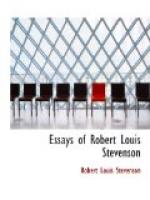without a tremor; and yet Faria is a thing of packthread
and Dantes[20] little more than a name. The sequel
is one long-drawn error, gloomy, bloody, unnatural
and dull; but as for these early chapters, I do not
believe there is another volume extant where you can
breathe the same unmingled atmosphere of romance.
It is very thin and light, to be sure, as on a high
mountain; but it is brisk and clear and sunny in proportion.
I saw the other day, with envy, an old and a very
clever lady setting forth on a second or third voyage
into
Monte Cristo. Here are stories which
powerfully affect the reader, which can be reperused
at any age, and where the characters are no more than
puppets. The bony fist of the showman visibly
propels them; their springs are an open secret; their
faces are of wood, their bellies filled with bran;
and yet we thrillingly partake of their adventures.
And the point may be illustrated still further.
The last interview between Lucy and Richard Feveril[21]
is pure drama; more than that, it is the strongest
scene, since Shakespeare, in the English tongue.
Their first meeting by the river, on the other hand,
is pure romance; it has nothing to do with character;
it might happen to any other boy and maiden, and be
none the less delightful for the change. And
yet I think he would be a bold man who should choose
between these passages. Thus, in the same book,
we may have two scenes, each capital in its order:
in the one, human passion, deep calling unto deep,
shall utter its genuine voice; in the second, according
circumstances, like instruments in tune, shall build
up a trivial but desirable incident, such as we love
to prefigure for ourselves; and in the end, in spite
of the critics, we may hesitate to give the preference
to either. The one may ask more genius—I
do not say it does; but at least the other dwells
as clearly in the memory.
True romantic art, again, makes a romance of all things.
It reaches into the highest abstraction of the ideal;
it does not refuse the most pedestrian realism. Robinson
Crusoe is as realistic as it is romantic:[22]
both qualities are pushed to an extreme, and neither
suffers. Nor does romance depend upon the material
importance of the incidents. To deal with strong
and deadly elements, banditti, pirates, war and murder,
is to conjure with great names, and, in the event of
failure, to double the disgrace. The arrival of
Haydn[23] and Consuelo at the Canon’s villa
is a very trifling incident; yet we may read a dozen
boisterous stories from beginning to end, and not receive
so fresh and stirring an impression of adventure.
It was the scene of Crusoe at the wreck, if I remember
rightly, that so bewitched my blacksmith. Nor
is the fact surprising. Every single article the
castaway recovers from the hulk is “a joy for
ever"[24] to the man who reads of them. They
are the things that should be found, and the bare
enumeration stirs the blood. I found a glimmer
of the same interest the other day in a new book,




